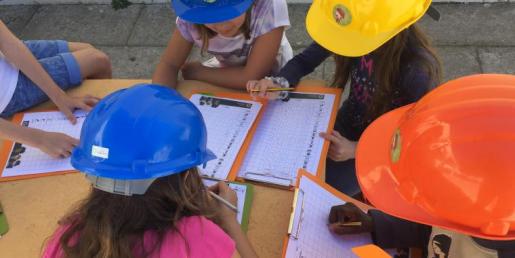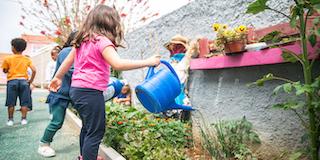

Launched in Cascais in the 2012/13 school year, with the aim of collaborating with educational establishments in the formation of more environmentally aware and participative citizens, this programme has become a complementary tool to the work of teachers, supporting their classes, both inside and outside the school grounds, thus encouraging the development of various themes within the scope of Education for the Environment and Citizenship. Find out all about this programme here
To see the English version, click on the EN box at the top right of the dashboard.
Want to access all the Interactive Data? Click here

This project for Cascais schools, created in the 2020/2021 school year, aims to promote greater interactivity between schools and the community. Each edition publicises initiatives carried out by students in the municipality, aimed at adopting more sustainable attitudes.

It complements the PESA by providing teachers/educators with tools. The educational exploration sheets are accompanied by activity proposals, trivia and, whenever possible, local examples so that students can understand the consequences their behaviour can have on the environment and quality of life.
- Promoting Education for Sustainable Development through didactic activities, developed in accordance with the curricular goals defined for the current school year;
- Encourage the promotion of cross-cutting themes within the scope of Citizenship Education, taking into account the guidelines of the Environmental Education Framework for Sustainability;
- Promote the principles of the ‘National Environmental Education Strategy’ in Cascais schools;
- Promote the Sustainable Development Goals;
- Valuing the various natural spaces and environmental education facilities in Cascais, recognising their importance in environmental sustainability and improving the quality of life in the municipality.
Cascais has an immeasurable natural asset, from coastline to the natural park, as well as its riverside. Aiming to enhance and maintain this richness, the municipality develops innovative and sustainable projects and activities, while seeking to address environmental and planet preservation challenges.
Cascais' network of air quality and meteorological sensors began monitoring in 2002, with the installation of a sensor in the center of Cascais. Since 2020, a system of eleven monitoring devices has been implemented, dedicated to the measurement of pollution and meteorology indicators.
These are distributed throughout the municipality, in order to ensure the representativeness of the measurements. The data is accessible and available on Open Data. The entity responsible is Cascais Ambiente.
Explore the stations' data here.
Find out more
Launched in March 2022, the iTree Project studies the impact of urban forestry.
Using its App, it's possible to identify the urban trees in Cascais and study their benefits. As an example, it shows the ecosystemic value of each one of the 15 000 urban trees identified in the municipality. As a result of the protocol with Instituto Superior de Agronomia, 2 600 trees of 130 different species have already been studied.
Cascais Smart Pole by NOVA SBE is the first living lab for decarbonization. It is located in Carcavelos and intents to promote actions through entrepreneurship and civic action for sustainable development and carbon neutrality. This project will follow both local and national goals set for 2050 with the aim of carbon neutrality.
Cascais Smart Pole is a partnership between Alfredo de Sousa Foundation, NOVA School of Business & Economics, Cascais Council, Cascais Ambiente, Get2C, PRIO BIO, Veolia and Avfallsteknisk Montasje AS (Norway) and funded by EEA Grants.
The Energy Matrix intends to diagnose the current energy consumption patterns in the municipality, and thus identify which sectors responsible for higher consumption, as well as which are the main sources of carbon dioxide emissions (the main greenhouse gas - GHG - responsible for climate change).
This analysis will allow the definition of mitigation strategies, but also identify opportunities to improve energy efficiency and the insertion of more renewable energies suitable for the municipality.
With analyses defined by 5-year periods, it is possible to identify consumption by types of energy and activity sectors.
2010-2015 Analysis | 2000-2005 Analysis
The Water Matrix characterizes and quantifies the main water flows in the municipality, identifying the main actors in the water cycle in Cascais.
This information allows for the definition of a set of measures and actions to meet the Sustainable Development Goals where water is targeted as the main element.
The study made it possible to synthesize information on the various stages of the water cycle (precipitation, runoff, water lines and artificial flows, water supply systems and wastewater and rainwater drainage), as well as to characterize the water balance of the municipality for a five-year period.
By understanding the various phases of the process and the parameters that influence it, stakeholders (as well as academics and citizens interested in the topic) can understand the efficiency of the cycle, and based on that, define targets that improve its performance, in order to meet the overall goals for aquifer sustainability.
AdaptCascais is a municipal fund to support associations and private entities in carrying out actions designed for climate change adaptation.
The 2021 edition funded 8 projects worth up to 3000€ each, in the following categories: Awareness, Communication and training campaigns; School engagement; Ecological requalification to reduce vulnerabilities; Natural-based solutions for green space promotion; and Water efficiency actions.
The project led to 163 activities involving 2 075 participants from 7 schools, and engaged 337 000 people on social networks. It has led to an improvement in environmental quality by the recover of 6 000 kg of plastic from the ocean, and 380 kg collected in our streets. As an addition, 91 trees were planted and 1 150m of natural streams were rehabilitated.
The Roadmap for Carbon Neutrality represents a natural evolution that consolidates the practices developed by the municipality in favour of the environment and the resilience of the territory and its populations. It aims to address climate change and the community's need to adapt.
Following the international goals for carbon neutrality and its pioneering role, the municipality started in 2019 a process to define achievable goals, based on an action plan.
The preparation of this plan contemplated several scenarios of GHG emissions based on a reference year (2015), which allows for the early solution of several challenges that may arise until 2050.
Based on the identification of the gap towards carbon neutrality, the best solutions are determined to set in motion faster mitigation processes over the coming years, not forgetting the involvement and proactive role of the community in the achievement of the objectives.


